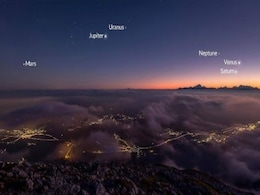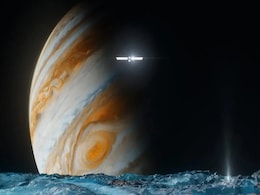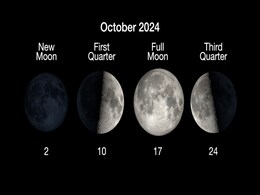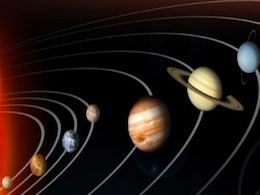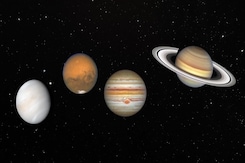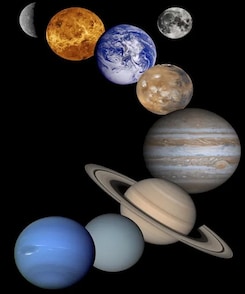Mars And Jupiter
- All
- News
- Videos
- Web Stories
-

Rare Seven-Planet Alignment 2025: How to Watch in India, Best Viewing Tips
- Monday February 24, 2025
- Written by Gadgets 360 Staff
A rare celestial event featuring seven planets—Mercury, Venus, Mars, Jupiter, Saturn, Uranus, and Neptune—aligning along the ecliptic will be visible in 2025. The alignment starts on February 28, with the best viewing in India on March 3. Venus and Jupiter will be easily visible, while Uranus and Neptune will require a telescope. Experts sugges...
-
 www.gadgets360.com
www.gadgets360.com
-

February 2025 Planet Parade: How to See Five Planets Align in the Sky
- Wednesday February 5, 2025
- Written by Gadgets 360 Staff
A rare celestial event will unfold in February 2025, with five bright planets—Venus, Jupiter, Mars, Mercury, and Saturn—visible in the evening sky. The highlight occurs on February 24, when Mercury and Saturn appear closest. Uranus and Neptune can also be observed with telescopes. Best viewing conditions require a clear west-southwest horizon a...
-
 www.gadgets360.com
www.gadgets360.com
-

Planetary Parade 2025: How And Where To See This Rare Celestial Event In India
- Saturday January 25, 2025
- Science | Edited by Bhavya Sukheja
Stargazers are in or a treat as six planets - Venus, Mars, Jupiter, Saturn, Neptune, and Uranus - are set to align in the night sky today, January 25, offering a spectacular view.
-
 www.ndtv.com
www.ndtv.com
-

James Webb Telescope Spots 138 New Asteroids in the Main Belt, Some Heading Towards Earth
- Tuesday December 17, 2024
- Written by Gadgets 360 Staff
Astronomers have discovered 138 new asteroids in the main asteroid belt between Mars and Jupiter using the James Webb Space Telescope (JWST). These decametre-sized asteroids, some of which are on paths that could bring them close to Earth, were identified through a new computational technique. The discovery enhances our understanding of small space...
-
 www.gadgets360.com
www.gadgets360.com
-

Space Exploration Highlights 2024: Lunar Missions, Mars Discoveries, and More
- Tuesday December 10, 2024
- Written by Gadgets 360 Staff
2024 saw significant space exploration advancements. Japan's SLIM mission exceeded expectations, while NASA’s Perseverance found evidence of ancient life on Mars. The Europa Clipper launched to investigate subsurface oceans on Jupiter's moon Europa, promising new discoveries by 2030.
-
 www.gadgets360.com
www.gadgets360.com
-

Super-Earth In the Solar System Could Have Rendered Our Planet Uninhabitable, Says Study
- Wednesday November 27, 2024
- Written by Gadgets 360 Staff
A recent study explores a hypothetical super-Earth between Mars and Jupiter, revealing its severe impact on Earth's orbit and climate. Conducted by Florida Institute of Technology scientists Emily Simpson and Howard Chen, the simulation demonstrates how such a planet’s gravity could destabilise neighbouring planets, causing erratic orbits and ext...
-
 www.gadgets360.com
www.gadgets360.com
-

NASA Europa Clipper Advances Toward Jupiter’s Moon, Instruments Successfully Deployed
- Tuesday November 26, 2024
- Written by Gadgets 360 Staff
NASA’s Europa Clipper spacecraft, launched in October 2024, is journeying toward Jupiter’s moon Europa to study its icy surface and hidden ocean. Currently over 13 million miles from Earth, the spacecraft has successfully deployed its solar arrays, magnetometer boom, and radar antennas. It will use a gravity assist from Mars in March 2025 to ad...
-
 www.gadgets360.com
www.gadgets360.com
-

November Night Sky 2024: Check Out the Brightest Planets and How to Watch Them?
- Monday November 4, 2024
- Written by Gadgets 360 Staff
November's night sky features a spectacular lineup of planets, including Venus, which becomes increasingly prominent in the west. Mars glows brightly as it approaches Earth, while Jupiter rises in the east, captivating observers with its brilliance. Saturn, with its magnificent rings, is also visible high in the southern sky. This month presents id...
-
 www.gadgets360.com
www.gadgets360.com
-

October 2024 Skywatching: Comet C/2023 A3, Venus, Saturn, Jupiter, and More Expect Over the Coming Weeks
- Friday October 4, 2024
- Written by Gadgets 360 Staff
October 2024 offers fantastic skywatching opportunities, including Comet C/2023 A3 visible from October 14-24, paired with beautiful planetary views of Venus, Saturn, Mars, and Jupiter. The full moon, Europa’s visibility, and other celestial events make this month perfect for sky enthusiasts. Grab your binoculars for an unforgettable experience!
-
 www.gadgets360.com
www.gadgets360.com
-

Mark Your Calendar for Aug 24 to Witness a Stunning Planet Parade Featuring 6 Planets in the Sky
- Sunday August 25, 2024
- Gadgets 360 Staff
On August 24, skywatchers will be treated to an impressive planetary parade featuring six planets: Saturn, Neptune, Uranus, Jupiter, Mars, and Mercury. This alignment, occurring in the early morning hours, will provide a unique viewing opportunity. In the US, the best time to catch the spectacle is between 5:45 a.m. ET and sunrise at 6:15 a.m. ET. ...
-
 www.gadgets360.com
www.gadgets360.com
-

Asteroid That Triggered Dinosaur Extinction Was a Carbon-Rich C-Type Space Rock, Study Finds
- Saturday August 17, 2024
- Written by Gadgets 360 Staff
Recent research has provided new insights into the asteroid that struck Earth 66 million years ago, causing a mass extinction event that led to the end of the dinosaurs. Scientists have now identified this impactor as a carbon-rich "C-type" asteroid, a type of space rock that likely originated in the asteroid belt between Mars and Jupiter.
-
 www.gadgets360.com
www.gadgets360.com
-

One Of The Brightest Stars To Disappear In "Once In A Lifetime" Event
- Monday December 11, 2023
- World News | Edited by Anoushka Sharma
The star has become prominent for its "fluctuating brightness". Several scientists have also raised concerns that it could explode soon.
-
 www.ndtv.com
www.ndtv.com
-

2,000-Year-Old Representation Of The Zodiac Uncovered In An Egyptian Temple
- Friday March 24, 2023
- World News | Edited by Nikhil Pandey
The images, executed in relief, include a complete depiction of the signs of the zodiac. Other reliefs show the planets Jupiter, Saturn and Mars.
-
 www.ndtv.com
www.ndtv.com
-

These 5 Planets Will Align Across The Night Sky On March 28
- Wednesday March 22, 2023
- Science | Edited by Anjali Thakur
Jupiter and Mercury will be located closer to the horizon, Venus and Uranus will appear higher up and Mars will shine near the moon.
-
 www.ndtv.com
www.ndtv.com
-

Rare Seven-Planet Alignment 2025: How to Watch in India, Best Viewing Tips
- Monday February 24, 2025
- Written by Gadgets 360 Staff
A rare celestial event featuring seven planets—Mercury, Venus, Mars, Jupiter, Saturn, Uranus, and Neptune—aligning along the ecliptic will be visible in 2025. The alignment starts on February 28, with the best viewing in India on March 3. Venus and Jupiter will be easily visible, while Uranus and Neptune will require a telescope. Experts sugges...
-
 www.gadgets360.com
www.gadgets360.com
-

February 2025 Planet Parade: How to See Five Planets Align in the Sky
- Wednesday February 5, 2025
- Written by Gadgets 360 Staff
A rare celestial event will unfold in February 2025, with five bright planets—Venus, Jupiter, Mars, Mercury, and Saturn—visible in the evening sky. The highlight occurs on February 24, when Mercury and Saturn appear closest. Uranus and Neptune can also be observed with telescopes. Best viewing conditions require a clear west-southwest horizon a...
-
 www.gadgets360.com
www.gadgets360.com
-

Planetary Parade 2025: How And Where To See This Rare Celestial Event In India
- Saturday January 25, 2025
- Science | Edited by Bhavya Sukheja
Stargazers are in or a treat as six planets - Venus, Mars, Jupiter, Saturn, Neptune, and Uranus - are set to align in the night sky today, January 25, offering a spectacular view.
-
 www.ndtv.com
www.ndtv.com
-

James Webb Telescope Spots 138 New Asteroids in the Main Belt, Some Heading Towards Earth
- Tuesday December 17, 2024
- Written by Gadgets 360 Staff
Astronomers have discovered 138 new asteroids in the main asteroid belt between Mars and Jupiter using the James Webb Space Telescope (JWST). These decametre-sized asteroids, some of which are on paths that could bring them close to Earth, were identified through a new computational technique. The discovery enhances our understanding of small space...
-
 www.gadgets360.com
www.gadgets360.com
-

Space Exploration Highlights 2024: Lunar Missions, Mars Discoveries, and More
- Tuesday December 10, 2024
- Written by Gadgets 360 Staff
2024 saw significant space exploration advancements. Japan's SLIM mission exceeded expectations, while NASA’s Perseverance found evidence of ancient life on Mars. The Europa Clipper launched to investigate subsurface oceans on Jupiter's moon Europa, promising new discoveries by 2030.
-
 www.gadgets360.com
www.gadgets360.com
-

Super-Earth In the Solar System Could Have Rendered Our Planet Uninhabitable, Says Study
- Wednesday November 27, 2024
- Written by Gadgets 360 Staff
A recent study explores a hypothetical super-Earth between Mars and Jupiter, revealing its severe impact on Earth's orbit and climate. Conducted by Florida Institute of Technology scientists Emily Simpson and Howard Chen, the simulation demonstrates how such a planet’s gravity could destabilise neighbouring planets, causing erratic orbits and ext...
-
 www.gadgets360.com
www.gadgets360.com
-

NASA Europa Clipper Advances Toward Jupiter’s Moon, Instruments Successfully Deployed
- Tuesday November 26, 2024
- Written by Gadgets 360 Staff
NASA’s Europa Clipper spacecraft, launched in October 2024, is journeying toward Jupiter’s moon Europa to study its icy surface and hidden ocean. Currently over 13 million miles from Earth, the spacecraft has successfully deployed its solar arrays, magnetometer boom, and radar antennas. It will use a gravity assist from Mars in March 2025 to ad...
-
 www.gadgets360.com
www.gadgets360.com
-

November Night Sky 2024: Check Out the Brightest Planets and How to Watch Them?
- Monday November 4, 2024
- Written by Gadgets 360 Staff
November's night sky features a spectacular lineup of planets, including Venus, which becomes increasingly prominent in the west. Mars glows brightly as it approaches Earth, while Jupiter rises in the east, captivating observers with its brilliance. Saturn, with its magnificent rings, is also visible high in the southern sky. This month presents id...
-
 www.gadgets360.com
www.gadgets360.com
-

October 2024 Skywatching: Comet C/2023 A3, Venus, Saturn, Jupiter, and More Expect Over the Coming Weeks
- Friday October 4, 2024
- Written by Gadgets 360 Staff
October 2024 offers fantastic skywatching opportunities, including Comet C/2023 A3 visible from October 14-24, paired with beautiful planetary views of Venus, Saturn, Mars, and Jupiter. The full moon, Europa’s visibility, and other celestial events make this month perfect for sky enthusiasts. Grab your binoculars for an unforgettable experience!
-
 www.gadgets360.com
www.gadgets360.com
-

Mark Your Calendar for Aug 24 to Witness a Stunning Planet Parade Featuring 6 Planets in the Sky
- Sunday August 25, 2024
- Gadgets 360 Staff
On August 24, skywatchers will be treated to an impressive planetary parade featuring six planets: Saturn, Neptune, Uranus, Jupiter, Mars, and Mercury. This alignment, occurring in the early morning hours, will provide a unique viewing opportunity. In the US, the best time to catch the spectacle is between 5:45 a.m. ET and sunrise at 6:15 a.m. ET. ...
-
 www.gadgets360.com
www.gadgets360.com
-

Asteroid That Triggered Dinosaur Extinction Was a Carbon-Rich C-Type Space Rock, Study Finds
- Saturday August 17, 2024
- Written by Gadgets 360 Staff
Recent research has provided new insights into the asteroid that struck Earth 66 million years ago, causing a mass extinction event that led to the end of the dinosaurs. Scientists have now identified this impactor as a carbon-rich "C-type" asteroid, a type of space rock that likely originated in the asteroid belt between Mars and Jupiter.
-
 www.gadgets360.com
www.gadgets360.com
-

One Of The Brightest Stars To Disappear In "Once In A Lifetime" Event
- Monday December 11, 2023
- World News | Edited by Anoushka Sharma
The star has become prominent for its "fluctuating brightness". Several scientists have also raised concerns that it could explode soon.
-
 www.ndtv.com
www.ndtv.com
-

2,000-Year-Old Representation Of The Zodiac Uncovered In An Egyptian Temple
- Friday March 24, 2023
- World News | Edited by Nikhil Pandey
The images, executed in relief, include a complete depiction of the signs of the zodiac. Other reliefs show the planets Jupiter, Saturn and Mars.
-
 www.ndtv.com
www.ndtv.com
-

These 5 Planets Will Align Across The Night Sky On March 28
- Wednesday March 22, 2023
- Science | Edited by Anjali Thakur
Jupiter and Mercury will be located closer to the horizon, Venus and Uranus will appear higher up and Mars will shine near the moon.
-
 www.ndtv.com
www.ndtv.com

